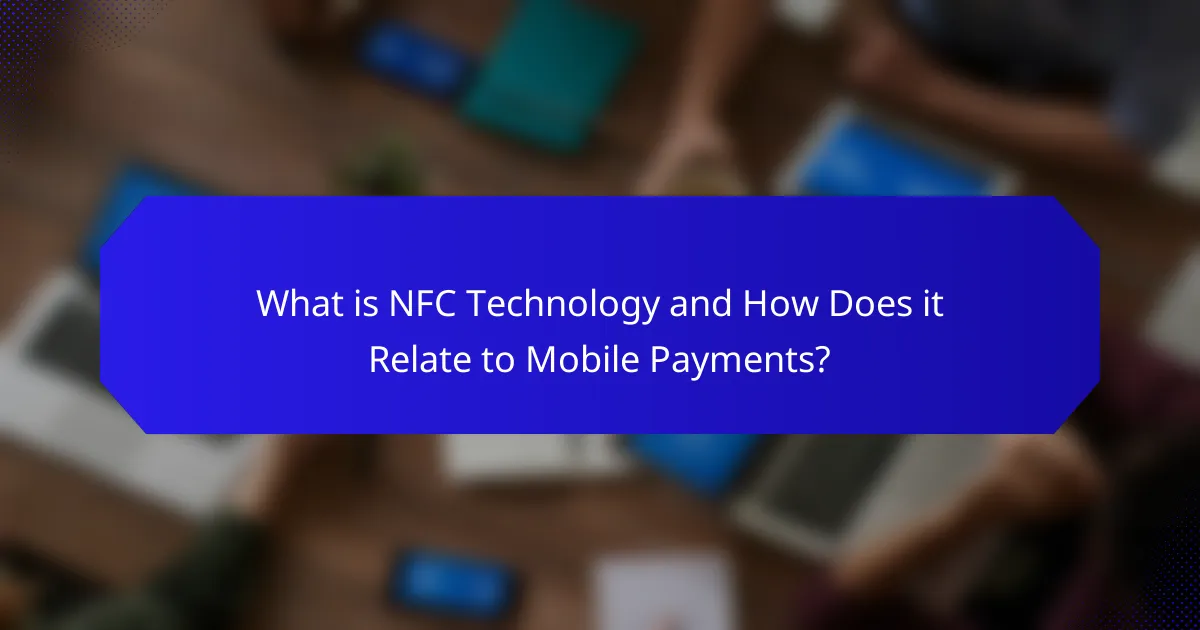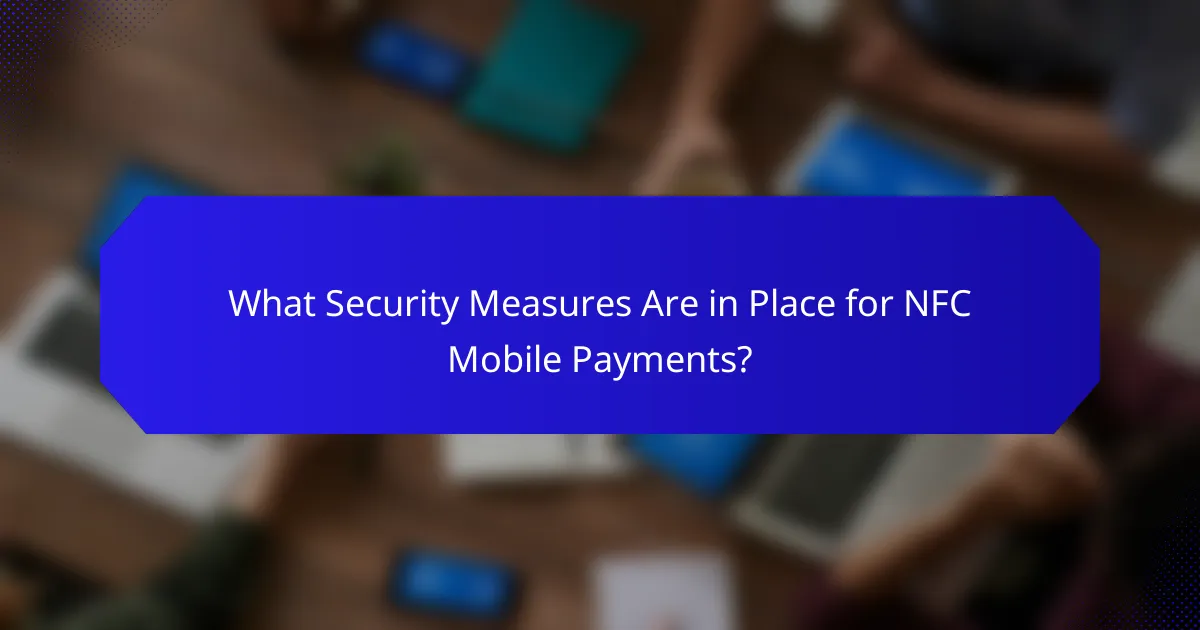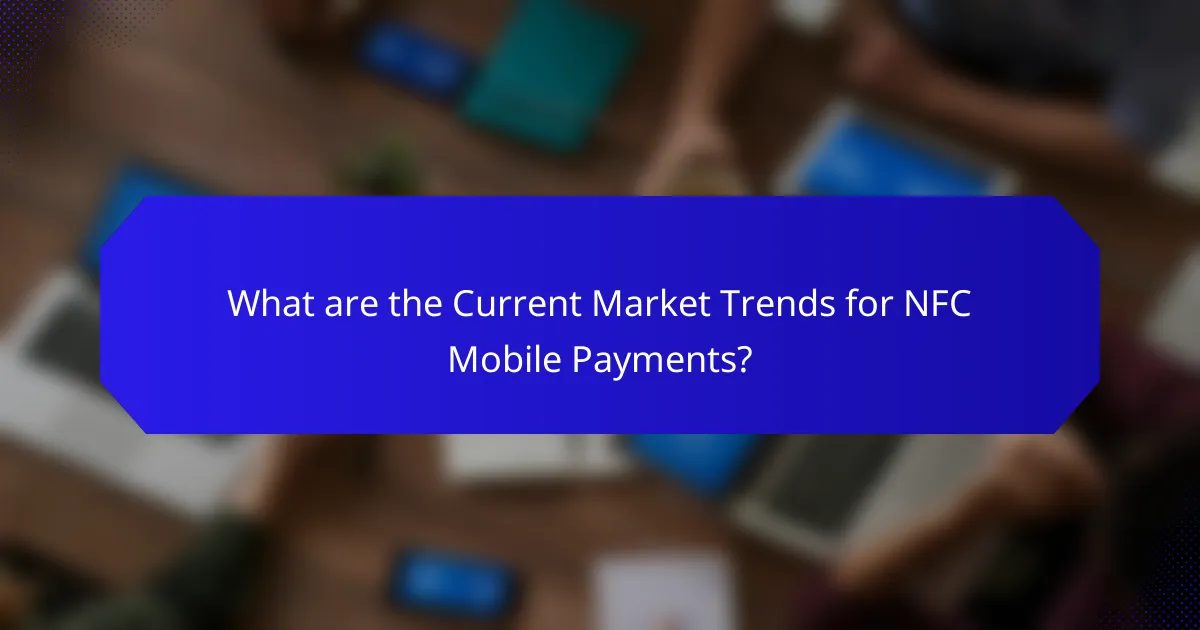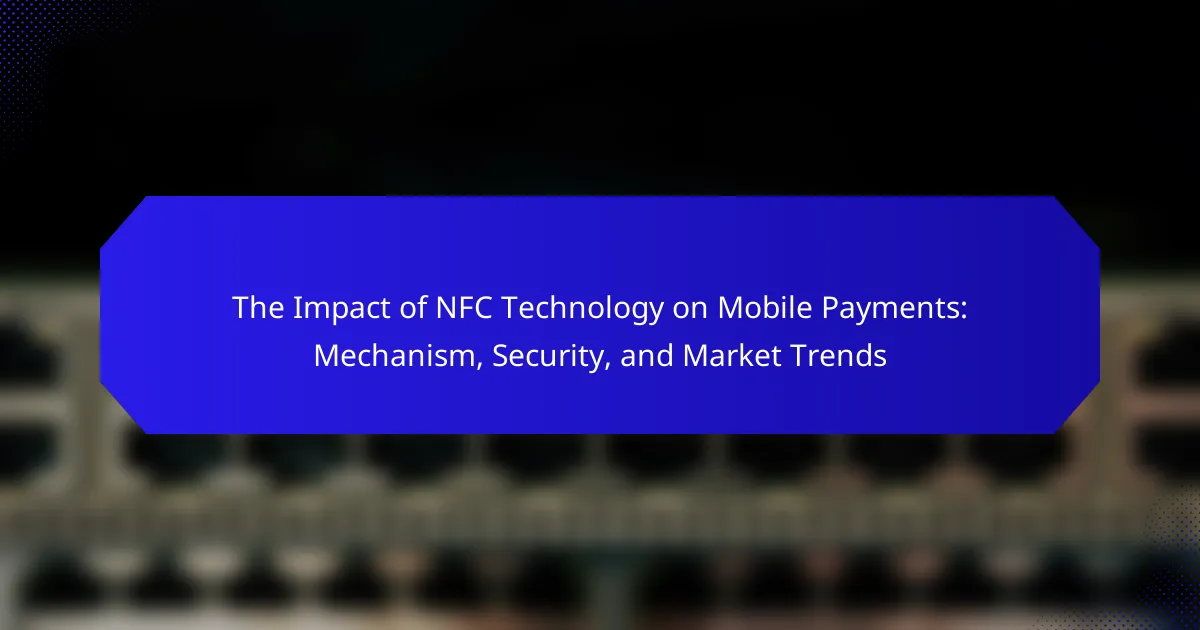NFC technology, or Near Field Communication, enables short-range wireless data exchange between devices, primarily used in mobile payment systems. This technology allows users to make secure, contactless transactions by tapping their NFC-enabled devices on compatible terminals. The article examines the mechanisms of NFC mobile payments, highlighting security measures such as encryption, tokenization, and biometric authentication that protect user data. Additionally, it explores current market trends, indicating significant growth in NFC payment adoption, driven by the increasing use of smartphones and digital wallets, with projections suggesting the global NFC payment market could reach $30 billion by 2026.

What is NFC Technology and How Does it Relate to Mobile Payments?
NFC technology, or Near Field Communication, is a set of communication protocols that enables close-range data exchange between devices. It allows smartphones and other devices to communicate wirelessly over short distances, typically within 4 centimeters. NFC technology is integral to mobile payments as it facilitates secure transactions by enabling contactless payment methods. Users can make payments by simply tapping their NFC-enabled device on a compatible payment terminal. This method is fast and convenient, reducing the need for physical cash or cards. According to a report by Statista, the global mobile payment market is projected to exceed $4 trillion by 2024, highlighting the growing adoption of NFC technology in financial transactions.
How does NFC technology function in mobile payment systems?
NFC technology enables mobile payment systems through short-range wireless communication. It operates by establishing a connection between two devices when they are in close proximity, typically within a few centimeters. One device, like a smartphone, contains an NFC chip that transmits payment information. The other device, often a payment terminal, receives this data to process the transaction.
This communication occurs using electromagnetic fields to transfer data. NFC payments are facilitated by a secure element within the smartphone that stores payment credentials. The technology employs encryption to protect sensitive information during the transaction.
According to a report by Juniper Research, NFC transactions are expected to reach $1 trillion globally by 2024, highlighting its growing adoption in the mobile payment sector.
What are the key components of NFC technology?
The key components of NFC technology include an NFC controller, NFC tags, and an NFC-enabled device. The NFC controller facilitates communication between devices. NFC tags store information and can be read by NFC-enabled devices. An NFC-enabled device, such as a smartphone, initiates and manages the communication. These components work together to enable contactless data exchange. NFC operates at a frequency of 13.56 MHz. It allows for data transfer rates up to 424 kbit/s. This technology is commonly used in mobile payments and secure transactions.
How does the communication process occur between devices?
The communication process between devices occurs through data exchange protocols. These protocols define how devices discover each other and establish a connection. In Near Field Communication (NFC), devices communicate when they are brought within a few centimeters of each other. The initiating device sends a signal to the target device, which responds to establish a connection. This process typically uses electromagnetic fields to transmit data. NFC operates at a frequency of 13.56 MHz, allowing for fast data transfer rates. The communication can involve various data formats, including URLs, contact information, or payment details. Security features are embedded in the NFC protocol to protect data during transmission. This ensures that sensitive information remains secure while devices communicate.
What advantages does NFC technology provide for mobile payments?
NFC technology provides several advantages for mobile payments. It enables quick transactions through simple tap-to-pay functionality. This method enhances user convenience and reduces transaction times. NFC transactions are generally secure due to encryption and tokenization methods. According to a study by Juniper Research, NFC mobile payment transactions are expected to reach $1 trillion by 2024, highlighting its growing adoption. Additionally, NFC does not require internet connectivity, allowing payments in offline environments. Its compatibility with various devices increases accessibility for users. Overall, NFC technology streamlines the payment process while maintaining high security.
How does NFC enhance transaction speed and convenience?
NFC enhances transaction speed and convenience by enabling contactless payments. This technology allows devices to communicate wirelessly over short distances. Users can complete transactions by simply tapping their device near a payment terminal. This process reduces the time spent on traditional payment methods, such as inserting cards or entering PINs. Studies show that NFC transactions can be completed in seconds. The ease of use also encourages more frequent transactions. In 2020, contactless payments accounted for over 40% of all in-store transactions in some regions. This demonstrates the growing preference for NFC technology among consumers.
What are the user experience benefits of using NFC for payments?
NFC technology enhances user experience in payments by providing convenience and speed. Users can complete transactions with a simple tap of their device. This eliminates the need for physical cash or cards. Transactions typically take less than a second. NFC payments also reduce the likelihood of errors during checkout. The seamless process improves customer satisfaction. According to a study by Juniper Research, NFC transactions are expected to exceed $1 trillion by 2024. This growth indicates increasing user adoption and preference for NFC payment methods.

What Security Measures Are in Place for NFC Mobile Payments?
NFC mobile payments utilize several security measures to protect transactions. These include encryption, tokenization, and secure elements. Encryption secures data during transmission, making it unreadable to unauthorized parties. Tokenization replaces sensitive information with unique identifiers, reducing the risk of data theft. Secure elements are tamper-resistant chips that store payment information safely. According to a study by the Federal Reserve, these measures significantly lower fraud risks. Additionally, biometric authentication, such as fingerprint or [censured] recognition, adds an extra layer of security. These combined measures enhance the overall safety of NFC mobile payment systems.
How does NFC technology ensure secure transactions?
NFC technology ensures secure transactions through encryption and short-range communication. It uses a secure element to store sensitive information. This secure element can be a chip embedded in the device. During a transaction, NFC encrypts data to protect it from interception. The short-range nature of NFC limits exposure to potential eavesdroppers. Additionally, NFC employs tokenization to replace sensitive data with unique identifiers. This process further enhances security by making data useless if intercepted. According to a study by the International Journal of Information Security, these features significantly reduce the risk of fraud.
What encryption methods are used in NFC transactions?
NFC transactions primarily use encryption methods such as AES (Advanced Encryption Standard) and RSA (Rivest-Shamir-Adleman). AES provides symmetric encryption, ensuring data confidentiality during transmission. RSA is utilized for secure key exchange and digital signatures. These encryption methods protect sensitive information like payment details and personal data. NFC technology adheres to security protocols like EMV (Europay, MasterCard, and Visa) standards, which mandate the use of these encryption techniques. The combination of AES and RSA significantly enhances the security of mobile payment systems.
How does tokenization protect sensitive information?
Tokenization protects sensitive information by replacing it with non-sensitive equivalents called tokens. These tokens are generated by a tokenization system and have no intrinsic value. When a transaction occurs, the token is used instead of the actual sensitive data, such as credit card numbers. This means that even if the token is intercepted, it cannot be used to access the original sensitive information.
Additionally, the original data is securely stored in a token vault, which is highly protected and only accessible by authorized systems. This separation of sensitive data from the transaction process significantly reduces the risk of data breaches. Studies show that organizations using tokenization have a lower incidence of data theft, as attackers cannot exploit tokens for fraud.
What are the potential security risks associated with NFC payments?
NFC payments face several potential security risks. One major risk is eavesdropping, where an attacker intercepts communication between the NFC device and the reader. This can lead to unauthorized access to sensitive payment information. Another risk is relay attacks, where an attacker uses two devices to capture and transmit information over a distance, tricking the NFC device into thinking it is in close proximity to the reader. Additionally, malware can compromise NFC-enabled devices, allowing attackers to manipulate transactions or steal data. According to a study by the University of Cambridge, 80% of NFC-enabled devices are vulnerable to such attacks. Furthermore, lost or stolen devices pose a risk, as they can be used to make unauthorized payments if not secured properly.
What types of fraud can occur with NFC mobile payments?
Types of fraud that can occur with NFC mobile payments include card skimming, transaction interception, and unauthorized access. Card skimming involves capturing payment information from a mobile device using a specialized reader. Transaction interception occurs when a hacker intercepts data during the payment process. Unauthorized access happens when an individual gains control of a mobile device to initiate fraudulent payments. According to a report from the European Union Agency for Cybersecurity, NFC technology is vulnerable to these types of fraud due to its reliance on wireless communication. In 2021, it was estimated that NFC-related fraud incidents increased by 25% compared to the previous year.
How can users mitigate security risks when using NFC technology?
Users can mitigate security risks when using NFC technology by following several best practices. First, they should disable NFC when not in use to prevent unauthorized access. Second, users should only use trusted applications for NFC transactions. Third, they should regularly update their device software to patch security vulnerabilities. Fourth, users can enable screen locks or biometric authentication for added security. Fifth, they should avoid conducting transactions in crowded areas to reduce the risk of interception. According to a study by the University of Cambridge, disabling NFC when not in use significantly decreases the likelihood of unauthorized access. Implementing these practices can help users protect their sensitive information during NFC transactions.

What are the Current Market Trends for NFC Mobile Payments?
The current market trends for NFC mobile payments indicate significant growth and adoption. The global NFC payment market is projected to reach $30 billion by 2026, growing at a CAGR of 20%. Increasing smartphone [censured] fuels this trend, with over 80% of smartphones supporting NFC technology. Retailers are increasingly adopting NFC systems for contactless payments, enhancing customer experience. In 2022, contactless transactions accounted for 50% of all in-store payments in major markets. Additionally, the rise of digital wallets, like Apple Pay and Google Pay, is driving NFC payment usage. Security enhancements, such as tokenization and biometric authentication, further boost consumer confidence in NFC transactions.
How is the adoption of NFC technology evolving across different regions?
The adoption of NFC technology is increasing globally, with variations across regions. In North America, mobile payments using NFC are projected to reach $1 trillion by 2025. Europe is also seeing growth, driven by contactless payment preferences. Asia-Pacific leads in adoption, with countries like China and Japan integrating NFC into daily transactions extensively. In Africa, NFC adoption is slower but rising, especially in urban areas. The global trend indicates a shift towards contactless payments, influenced by consumer demand for convenience and security.
What factors are driving the growth of NFC mobile payments?
The growth of NFC mobile payments is driven by convenience, increased smartphone adoption, and enhanced security features. Convenience arises from quick transactions that require just a tap. Increased smartphone adoption facilitates wider accessibility to NFC technology. Enhanced security features, such as tokenization and biometric authentication, build user trust. According to a report by Statista, the global mobile payment market is expected to reach $12 trillion by 2025. This growth reflects consumer preference for seamless payment experiences. Additionally, the COVID-19 pandemic accelerated the shift towards contactless payments, further boosting NFC adoption.
Which industries are leading in NFC adoption?
The retail and payment industries are leading in NFC adoption. Retailers utilize NFC for contactless payments to enhance customer convenience. Payment service providers integrate NFC technology to streamline transactions. The transportation sector also adopts NFC for ticketing solutions. Additionally, the hospitality industry uses NFC for mobile check-ins and room access. In 2021, the global NFC market was valued at approximately $11 billion, indicating rapid growth. According to a report by MarketsandMarkets, the NFC market is expected to reach $34 billion by 2026, highlighting its increasing relevance across various sectors.
What future developments can we expect in NFC mobile payment technology?
Future developments in NFC mobile payment technology will likely include enhanced security features. Biometric authentication methods, such as fingerprint and [censured] recognition, are expected to become more prevalent. These methods will provide an additional layer of protection against fraud. Integration with blockchain technology is also anticipated. This integration could improve transaction transparency and reduce processing times.
Furthermore, the adoption of 5G technology will facilitate faster data transmission. This will enhance the user experience during transactions. Increased interoperability between devices and platforms is another expected development. This will allow users to make payments across different ecosystems seamlessly.
Finally, the expansion of NFC-enabled wearables is on the horizon. Devices like smartwatches and fitness trackers will increasingly support mobile payments. This trend aligns with the growing consumer demand for convenience and efficiency in financial transactions.
How might emerging technologies impact NFC payment systems?
Emerging technologies will significantly enhance NFC payment systems. Innovations such as blockchain can improve transaction security and transparency. Artificial intelligence can streamline fraud detection and customer service. Biometric authentication methods can strengthen user verification processes. Additionally, the Internet of Things can facilitate seamless transactions across multiple devices. These advancements may lead to faster processing times and increased user trust. According to a report by MarketsandMarkets, the global NFC market is expected to grow from $11.4 billion in 2020 to $34.3 billion by 2026, showcasing the impact of these technologies.
What role will consumer behavior play in shaping future trends?
Consumer behavior will significantly influence future trends in mobile payments. As consumers increasingly prefer contactless transactions, the adoption of NFC technology will rise. Research shows that 70% of consumers favor mobile payments for their convenience and speed. This preference drives businesses to adopt NFC technology to meet customer demands. Additionally, consumer attitudes towards security will shape the features offered by mobile payment systems. Trust in mobile payment security affects user adoption rates. Companies must adapt to these behaviors to remain competitive in the evolving market.
What best practices should consumers follow for using NFC mobile payments safely?
To use NFC mobile payments safely, consumers should follow several best practices. First, always ensure that your mobile device has the latest security updates installed. Regular updates help protect against vulnerabilities. Second, enable biometric authentication, such as fingerprint or [censured] recognition, for added security. This feature ensures that only the authorized user can make payments. Third, avoid using public Wi-Fi networks for transactions. Public networks can expose your data to potential hackers. Fourth, monitor your bank statements regularly for unauthorized transactions. Quick detection of fraud can minimize losses. Lastly, disable NFC when not in use. This prevents unauthorized access to your payment information. Following these practices significantly enhances the security of NFC mobile payments.
How can users ensure their devices are secure when making NFC transactions?
Users can ensure their devices are secure when making NFC transactions by following several key practices. First, they should keep their device’s operating system and applications up to date. Regular updates often include security patches that protect against vulnerabilities. Second, users should enable security features such as biometric authentication or strong passwords. This adds an extra layer of protection against unauthorized access. Third, users should disable NFC when not in use to prevent unintended transactions. Fourth, they should be cautious about connecting to public Wi-Fi networks while making transactions. Public networks can expose devices to security risks. Lastly, users should regularly monitor their bank statements for any unauthorized transactions, allowing for quick action if fraud occurs. These practices collectively enhance the security of NFC transactions.
What tips can help users maximize the benefits of NFC technology?
To maximize the benefits of NFC technology, users should ensure their devices support NFC. This enables seamless transactions and data transfers. Users should also keep their NFC settings enabled for quick access. Regularly updating device software enhances security and functionality. Utilizing NFC-enabled payment apps can streamline purchases. Users should be aware of their surroundings to prevent unauthorized access. Lastly, they should consider using NFC for sharing files, contacts, and links efficiently. These practices ensure optimal use of NFC technology in daily transactions.
NFC technology, or Near Field Communication, is a set of communication protocols enabling close-range data exchange, primarily used in mobile payments for secure and contactless transactions. This article explores how NFC functions in mobile payment systems, detailing its key components, advantages, and the security measures in place to protect users. It also examines current market trends and the factors driving the growth of NFC mobile payments, along with best practices for consumers to enhance their security while using this technology. Overall, the piece provides a comprehensive overview of NFC’s impact on the mobile payment landscape, highlighting its mechanisms, security features, and evolving market dynamics.
